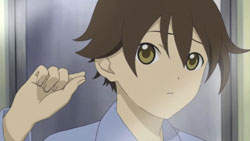 |
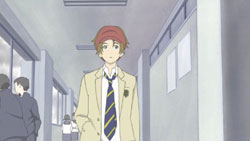 |
 |
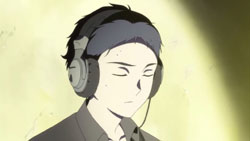 |
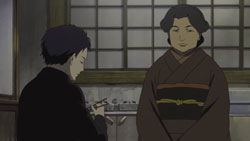 |
 |
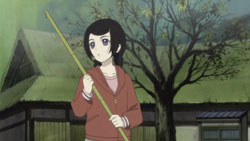 |
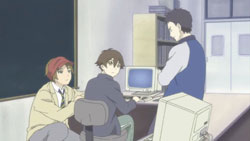 |
 |
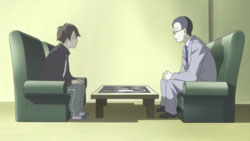 |
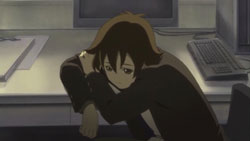 |
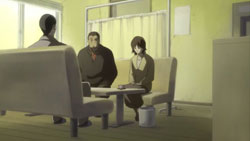 |
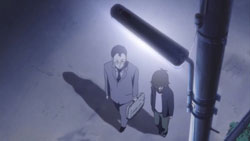 |
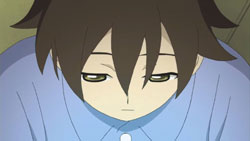 |
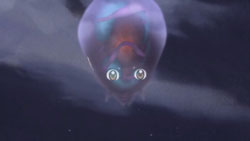 |
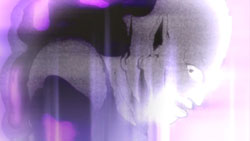 |
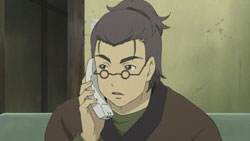 |
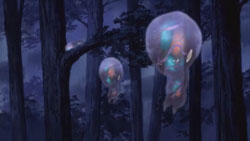 |
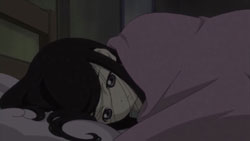 |
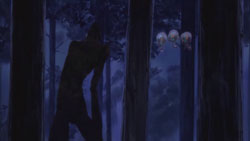 |
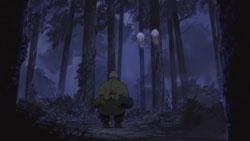 |
It has been raining, and the dam has now filled up – the ruins of the Kameiwa Respiratory Hospital are mostly underwater now. Tarou wakes up, and has breakfast; he is still quite conscious of his forced haircut by Takahito the night before. Tarou informs his father that the school counselor, Hirata, wishes to visit soon and sets off for school.
Tarou spots a headband-wearing Masayuki in the hallways, who sheepishly grins at him before entering the classroom. Makoto also attends school that day, although he is once again tardy. As expected, Masayuki walks up to Makoto in an all-too-casual fashion. Makoto isn’t exactly pleased to talk to the loud and attention-getting Masayuki; he grabs Masayuki by the collar as he did the day before and silences the lighthearted one with the magic words, “Should I make you fall off from the rooftop of this building?”
A few days pass. Tarou pedals his bike to school as always, and spends a lot of time sleeping. Makoto, similarly, spends most of his free time practicing the guitar during these days. Masayuki is spending his time in virtual reality thanks to his head-mounted display. He temporarily takes it off for a second, but slips it back on as he hears his parents argue downstairs.
Makoto now has dinner in the dark kitchen of his house, and an attendant informs him that “hime-sama” (his grandmother) wishes to see him once he is finished. Makoto doesn’t look happy at all with this request, but he proceeds to meet her. Himeko, his grandmother, appears behind him and proceeds to talk. She tells Makoto to begin training as the heir of the Oogami cult if he doesn’t show any interest in pursuing academic excellence in high school (high school is voluntary, not mandatory in Japan). Makoto of course has no interest in taking over the new religion his family is part of, and proceeds to open the room his father was found dead in – all to the utter dismay of Himeko. Tensions fly, and he yells that his father wasn’t interested in being the new leader of the Oogami cult, and he has no intentions of being one either.
Way up in the Kameiwa Shrine, we see Miyako sweeping the shrine grounds as she usually does. She glances at an elderly man roaming around the forest nearby, before she shifts her attention to her father, Takahito. Takahito is worried for Miyako’s recent experiences with the kakuriyo/spiritual realm, but Miyako tells him to stop being concerned – it isn’t as bad as before, according to her.
Back at school, the three male protagonists have an awkward encounter in the bathroom (Masayuki: “See, we really are connected by fate”) before they all enter the library. Oddly enough, all three of them have not undergone any out-of-body-experiences since visiting the dam and hospital. Makoto, who is the most informed when it comes to spiritual material, goes on to talk that all three of them saw spirits during the hospital escapade. He hypothesizes that the area around the Kameiwa Dam is some kind of entrance from the utsushiyo (the real world) into the kakuriyo.
The school day officially ends, and Tarou is in the principal’s office with Hirata, the psychologist. Before they both leave for Tarou’s home, Tarou asks Hirata if OBEs are in fact real – his answer is indirect, as he states that there are reports of it that claim it is real. Hirata talks about OBE initially being connected with spiritual experiences, and how some academic institutes specializing in neurology have conducted research concerning it. He also states, however, that from a sensory standpoint, he finds OBE to be very similar to (if not mistaken as)
離人症性障害/rijinshouseishougai, or depersonalization disorder. He goes on to explain that this is a form of dissociative disorder where sufferers constantly feel themselves disconnected from their body, and have a challenging time connecting themselves with reality; while it is normally associated with post-traumatic stress disorder, Hirata notes that more and more seemingly-normal people are claiming to have the condition as well. He also finds it fascinating that electronic stimulation of a region of the brain called the angular gyrus can create sensory experiences that may be identified as OBE. Poor Tarou is lost in thought with all this psychology talk.
The Komori family first give Hirata a tour of the family’s sake brewing facilities with the help of Kei-san (who appeared briefly in episode one). With this over with, the discussion between Hirata and Tarou’s parents formally begins – Tarou himself is somewhat hidden from view behind a large computer monitor. We learn that Hirata doesn’t live in the town of Suitenchou; in fact, he commutes to Suitenchou from Tokyo several times during the week. Hirata praises Tarou’s condition and his positive outlook towards life before addressing his mother, who he (and us, the viewers) observes is several times more stressed and traumatized than her son is. Tarou’s mom does her trademark eye twitch, as her husband interjects and state that his wife is doing well, as she is taking medicine and visiting the local psychiatric clinic. Hirata’s expressionless face almost suggests doubt at the father’s story, although he stops pressing the issue any further.
Hirata leaves the Komori household, although Tarou is outside and walks up to the psychologist. To no one’s surprise, Hirata is more concerned for Tarou’s mother; he promises Tarou to try his best and help her. Tarou mentions here also that his mother’s severe case of trauma isn’t only caused by the kidnapping he and Mizuka were victims of – she was on the receiving end of countless ill-wishing prank calls during the kidnapping incident of her two children (talk about adding insult to injury…). Tarou gets pretty emotional and teary-eyed at this point, and he tells Hirata that his greatest fear is to see his mother go insane.
After sending Hirata off, Tarou is back in his room; it doesn’t take a while before he falls asleep and enters the state of 魂抜け/tamanuke. The astral form of Tarou floats around the nighttime sky, as he tells himself that what he is experiencing possibly can’t be a dissociative disorder. He stops by at what looks like glowing purple zombies (?) before flying off and running into the souls of Makoto and Masayuki. While this is happening we see Takahito calling someone and seeking medical advice on Miyako – he believes that Miyako is displaying signs of dissociative disorders (he mentions multiple personality disorder, or dissociative identity disorder). He doesn’t know that Miyako is actually awake and is eavesdropping on the conversation.
The adventures of the three little souls carry on. They visit the mainly underwater Kameiwa Respiratory Hospital and come into contact with a spirit that looks like a bizarre cross between a bird and a bat. They also come into contact with the giant shadow from Tarou’s nightmares, although Tarou’s mention of his kidnapping and his futile attempt in remembering what the kidnapper looked like touches Makoto’s nerve. He leaves the other two in the forest, as Masayuki and Tarou’s souls come across the same old man walking around the Kameiwa Shrine grounds a bit earlier. The old man can actually see them, and makes a further (correct) observation that he is looking at the souls of kids. ED rolls in…
Preview:
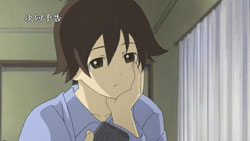 |
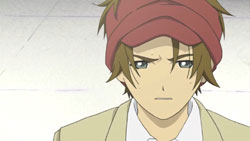 |
 |
A lot happened, although I should start first by addressing Hirata. I actually had to go through a Japanese medical dictionary to pinpoint what exactly he was talking about, although all this usage of psychology terms was informative in the long run. He promises to help Tarou’s mother, although I can’t exactly picture how he can succeed, let alone begin treating her. This episode also brings into light the challenges the three male protagonists face in their lives. As stated above, Tarou is worried sick for his mother’s mental health; Masayuki, meanwhile, has to deal with his parents’ bickering and dysfunctional relationship. Makoto is faced with the unusual burden of leading his family’s religion, the Oogami cult, though it is fair to say that he has zero intentions of following in his deranged grandmother’s footsteps. Miyako, the only heroine, is not really facing a problem per se, although her father sure seems to find her mentally unstable. I wonder if he was talking to Hirata on the phone?
It’s funny how two of the shows I’m watching and blogging – this and Moyashimon – have sake brewing being a family-run business for the major characters…
Next time: The scenes from the preview aren’t exactly helpful in giving us an idea of what might happen, although the confrontation between the mysterious senior citizen and the astral projections of Masayuki/Tarou will take place. The title for next week’s episode is “The Brain Homunculus,” which isn’t much of a hint either. The background dialogue by Miyako is about John Keel and the Unidentified Mysterious Animal, Mothman. I am serious, folks.

Can’t wait for it!Many thanks!Take your time to write the review
This episode was awesome too. Seems like Masayuki’s parents are always arguing… Looking forward to summary. Thanks for blogging GH 🙂
Be ready people TSUBASA CHRONICLE TOKYO REVELATIONS maybe avaiable TODAY in RAW…
IPI IPI UHA!!
IPI IPI UHA!!
IPI IPI UHA!!
I love you Clamp no mina san!!!!!
I really want to know what Makoto and his grandmother were fighting about.
@ SquirrelLuvsPnut:
It’s pretty much about the future of the new religion the Oogami household has been leading. Since Makoto isn’t much of a high-achieving student in school, his grandmother (Himeko) wants him to not attend high school and instead enter religious training.
Makoto of course declines this offer 😀
Mothman is scary…..the history on it….over all, this show gives me the creeps, even if it is good
isn’t mothman the “ghost” makoto chased?
probably the trigger of the O.B.E. for the three was the stress they receive from their family?
Nice, this is starting to get really interesting. I love the mood.